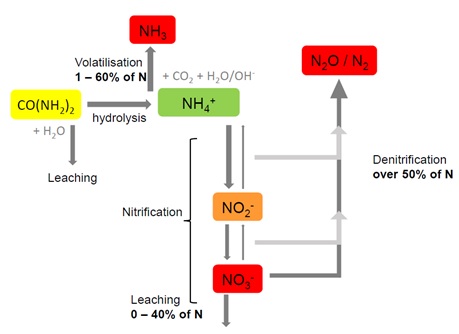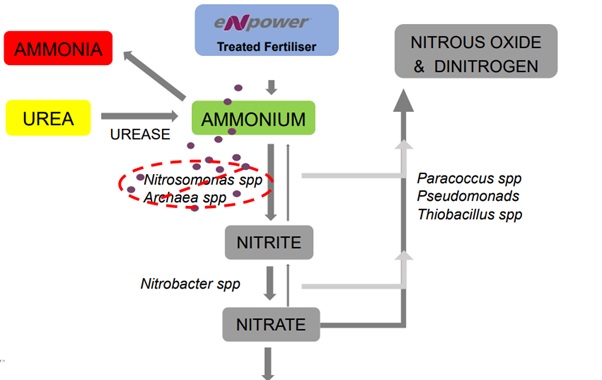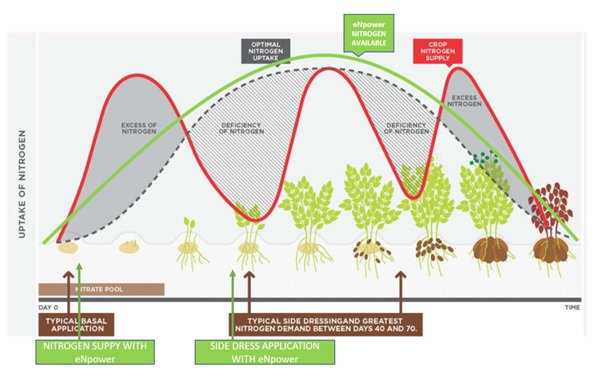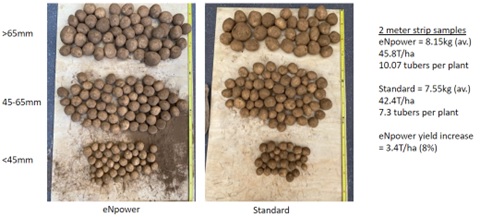Agronomic Insights

Natalia Gomez – IPF Technical Agronomist
As the Southern potato season approaches, potato growers face a critical challenge: how to achieve optimal yields and quality while maximising the return on investment from nitrogen fertilisers.
This challenge necessitates the adoption of an efficient approach to nitrogen management that minimises loss while optimising timing. In this dynamic context, eNpower (Efficient Nutrition with Staying Power) emerges as a revolutionary solution that offers compelling reasons for potato growers to consider its incorporation into their farming practices, thus contributing to both enhanced agricultural sustainability and environmental benefits.
Nitrogen Cycle: Understanding Loss Pathways in Potato Farming
Deciding on the right amount of nitrogen (N) fertiliser is a key decision for growers, affecting the success of each crop in terms of not just yield, but quality parameters such as size, shape, and specific gravity etc. Balancing tuber yield and size (depending on the end market) requires smart N management. Too much N, the wrong timing or the wrong product choice can harm tuber quality, waste money, and affect the environment. Identifying the perfect rate for N fertiliser is tricky as soil N levels are different in every field and every season and potato varieties have different N requirements.
While various sources contribute to the presence of nitrogen and availability, the innate mobility of this element combined with nutrient demand and crop growth timing, introduces a very distinct challenge for growers, particularly where large amounts of N are applied at or prior to planting and in particular in ‘leaky soils’.
The problem is, N tends to escape with ease from the potato root zone once in the nitrate form. This happens due to a process referred to as nitrification – the conversion of ammonium (NH4+) based fertilisers such as MAP of DAP to nitrate (NO3-). Nitrate moves in the soil solution so can move out of the plant root zone, into water bodies, or diffusing into the atmosphere as nitrous oxide (a potent greenhouse gas).
Adding complexity to the equation are the financial considerations associated with the loss of purchased nitrogen. This presents a double challenge, as it not only impacts the growers’ budgets but also poses a threat to both the yield and quality of the crop when the nutrient is unavailable precisely when the crop needs it.
These nitrogen loss pathways compound the challenge (Figure 1):
- Leaching: Negatively charged nitrate ions are subjected to leaching through the soil profile, leading to a redistribution or complete removal of nitrate in the root zone.
- Denitrification: the conversion of ammonium or nitrate to nitrous oxide, nitric oxide, or nitrogen gas under anaerobic, warning conditions.
- Volatilisation: the loss of ammonium ions by oxidation to ammonium gas.

Maximising Nitrogen Efficiency and Solving Nitrogen Loss Pathways with eNpower
eNpower (Efficient Nutrition with Staying Power) is an ammonium- product, that when applied to nitrogen fertiliser, offers the potential to improve nitrogen use efficiencies, and helps ensure N applied at or prior to planting remains largely available to the crop as demand increases, typically around tuber initiation and rapid vegetative growth stages. This allows for equivalent, if not improved, yields and a better bottom line while minimising the loss of nitrogen to the environment as a greenhouse gas or nutrient.
This eNpower formulation is compatible with many different IPF (Incitec Pivot Fertilisers) nitrogen products like DAP, MAP, Gran Am, Urea, NPKS Compound, Easy N and custom blends. Please check with IPF for a full list of compatibilities and availability tables.
eNpower operates by inhibiting the bacteria and fungi responsible for enzyme production in the conversion of ammonium to nitrate. This intentional inhibitor reduces and decelerates their enzymatic activities. In simple terms, eNpower slows the rate of nitrification. Consequently, the conversion of ammonium nitrate into nitrate takes place at a more gradual pace (Figure 2).

When discussing N fertilisation in potatoes, the initial application takes place before the critical growth stage, constituting up to 70% of the required N fertilisation depending on grower’s individual operational management, variety and soil type. However, since potatoes demand a lesser amount of N at this point, the risk of nutrient loss is higher. As a result, during the period of 20 to 60 days after planting (depending on time of planting), the phase when the potato plants experience heightened nitrogen demand, availability becomes insufficient as the N can largely be lost. To address this, additional applications must be carried out to guarantee the presence of nitrogen precisely when the plants require it (Figure 3).
eNpower is a prime solution for mitigating nitrogen losses application and ensuring its retention during crucial periods. This innovative product excels in maintaining an extended reservoir of accessible nitrogen in the ammonium form, effectively stabilising its presence within the soil, and thereby extending its availability to the crop. Typically, the nitrification and denitrification process can range of 1 to 3 weeks. However, with the integration of eNpower, this process can be extended from 4 to 10 weeks. The temporal variation aligns with prevailing soil temperature, moisture content, and organic matter levels Figure 3.

Empowering Sustainability: eNpower’s Dual Role in Enhancing Potatoes and Reducing N2O Emissions
Addressing the issue of nitrous oxide (N2O) emissions is a critical global concern, N2O is a potent greenhouse gas and there is a need to develop innovative solutions that can improve crop characteristics and reduce N2O emissions within the Australian potato industry.
eNpower not only improves crop characteristics but also actively reduces N2O emissions. This dual functionality holds immense significance for potato growers in Australia, who play a vital role in the country’s agriculture sector.
By choosing eNpower, potato growers in Australia optimise their crop yields and quality while actively mitigating the environmental impact of potato farming. This integrated approach signifies a progressive step toward a more sustainable and responsible future for the Australian potato industry. It aligns with the industry’s commitment to environmental stewardship and contributes to Australia’s broader goals of sustainable agriculture and reduced greenhouse gas emissions.
eNpower’s Nitrogen Management Success
A series of non-replicated demonstrations conducted across diverse geographical regions, the efficacy of optimising nitrogen management through the integration of eNpower. The main objective of these trials was to assess the effectiveness of eNpower in reducing nitrogen loss while enhancing potato yield, size uniformity, and nutrient use efficiency.
Langhorne Creek, South Australia Trial
The Langhorne Creek trial corroborated the effectiveness of eNpower. The application of eNpower led to a remarkable 7% increase in yield. This tangible improvement underlines its role in mitigating nitrogen loss and augmenting crop output, setting the stage for more sustainable and prosperous potato cultivation practices.
Koroit, Victoria Trial
In Koroit, Victoria, eNpower once again demonstrated its prowess. The area treated with eNpower displayed a yield of 45.8 t/ha, accompanied by an impressive tuber count of 10.07 per plant. In contrast, the standard nitrogen application resulted in a yield of 42.4 t/ha and 7.3 tubers per plant. This translated into an 8% increase in yield attributed to the incorporation of eNpower, further highlighting its efficacy in maximizing potato harvests Figure 4.

Before embarking on any fertiliser application in your agricultural practices, it is critical to undertake a comprehensive soil analysis and establish a routine for consistent monitoring of the nutritional status of your crops through tissue tests in collaboration with a qualified agronomist. These essential steps are the base of effective and sustainable farming practices, ensuring that your crops receive the precise nutrients they need for optimal growth and productivity.
For accurate and reliable results in both soil analysis and tissue tests, we highly recommend utilising the services of the Nutrient Advantage Laboratory. Equipped with the best technology and staffed by experts in the field, this laboratory ensures the utmost precision in nutrient analysis. Choosing the Nutrient Advantage Laboratory as your testing partner means you can confidently make data-driven decisions that benefit your crops and contribute to the sustainability and success of your farming operation.
Further information
For more information on fertiliser programs for potato crops, feel free to contact me at natalia.gomez@incitecpivot.com.au or +61 427 232 982.
References
Rosen, C.J., and R. Eliason. 2005. Nutrient management for commercial fruit & vegetable crops in Minnesota (BU-05886). University of Minnesota Extension Service, St. Paul. http://hdl.handle.net/11299/51272 (accessed 30 August 2023).
DISCLAIMER
This is a guide only, which we hope you find useful as a general tool. While IPF has taken all reasonable care in the preparation of this guide, it should not be relied on as a substitute for tailored professional advice and IPF accepts no liability in connection with this guide. Incitec Pivot Fertilisers manufactures and sources fertilisers from other suppliers. The fertiliser supply chain extends beyond the company’s direct control, both overseas and within Australia. Incitec Pivot Fertilisers hereby expressly disclaims liability to any person, property or thing in respect of any of the consequences of anything done or omitted to be done by any person in reliance, whether wholly or in part, upon the whole or any part of the contents of this article.
You might also be interested in these

Horticulture
Milking the post-harvest window for almonds
April / 2024

Pasture
Getting the most out of winter nitrogen: practical tips for pasture productivity
May / 2025

Horticulture
Soil sampling to depth in horticulture
August / 2023

Horticulture, Pasture, Sugar, Summer Crop
Loveday & Pyle test – a comprehensive indicator of soil stability
February / 2023

